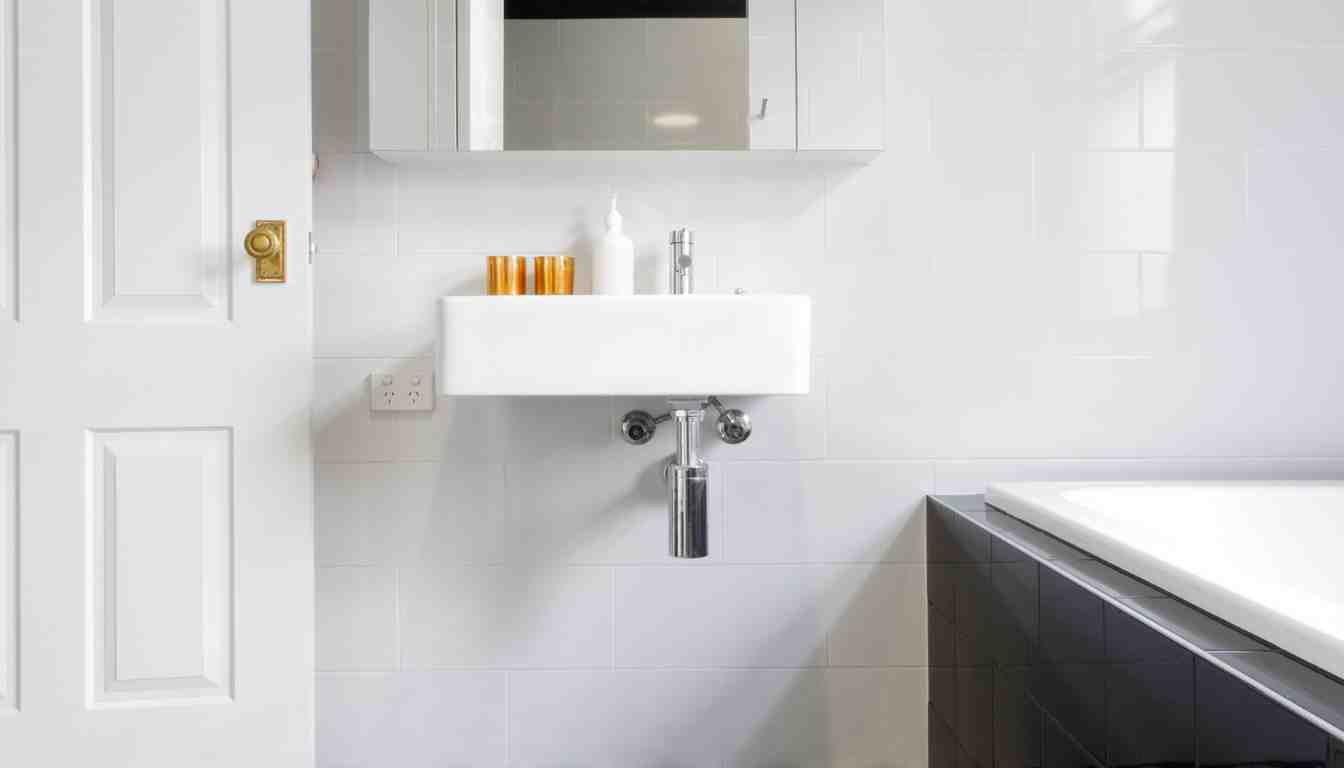Wood floors in the bathroom can be susceptible to water damage if not properly sealed with polyurethane, leading to buckling and warping over time. For a water-resistant option, consider White Oak, Hickory, or Maple for increased durability in a bathroom setting.
Finishes like polyurethane are recommended to create a protective barrier on the wood floor. Modern materials and sealants have made wood floors in bathrooms a more practical choice today. Waterproofing can be achieved with products like lacquer, varnish, and sealants for added protection against moisture.
With careful consideration and proper maintenance, wood floors can be a stylish and functional addition to your bathroom.
Benefits Of Wood Floors In The Bathroom
Wood floors in the bathroom add warmth and character while creating a stylish, natural look. With proper sealing, wood floors can withstand moisture and provide a durable, low-maintenance option. Additionally, certain wood species offer resistance to water and heavy foot traffic, making them ideal for bathroom use.
Water-resistance
Wood floors in the bathroom offer excellent water-resistance when properly sealed with polyurethane. Unlike other flooring types, hardwood floors can withstand moisture without warping or buckling.
Aesthetic Appeal
Wood floors bring a timeless and elegant look to the bathroom, enhancing the overall aesthetic appeal of the space. They add warmth and beauty to the decor, creating a cozy and inviting atmosphere.

Credit: www.linkedin.com
Best Wood Options For Bathroom Floors
Discover the ideal wood options for bathroom floors that combine durability and water resistance. White Oak stands out for its water-resistant properties, while Hickory and Maple offer robustness against heavy foot traffic, ensuring a practical and stylish flooring solution for your bathroom space.
White Oak
When it comes to bathroom wood floors, White Oak stands out as a top choice for its water resistance and durability. This wood species can withstand moisture better than many others, making it ideal for bathrooms.
Hickory And Maple
Hickory and Maple are hardwood options known for their toughness and ability to withstand heavy foot traffic. These woods can offer excellent protection against wear and tear in bathroom settings.
Waterproofing Wood Floors For The Bathroom
Wood floors in the bathroom can add warmth and natural beauty to the space, but they require special attention to ensure they can withstand the moisture and humidity that comes with this environment. Waterproofing wood floors for the bathroom is essential to prevent damage and maintain the longevity of the flooring. There are various water-resistant products and finishes that can be used to protect wood floors in the bathroom, ensuring they stay in top condition for years to come.
Water-resistant Products
When it comes to waterproofing wood floors for the bathroom, using water-resistant products is crucial. Various options are available in the market today, such as lacquer, varnish, stain and sealant combination, linseed oil, and tung oil. These products can provide a protective barrier against moisture, preventing water from seeping into the wood and causing damage. It’s important to choose a product that is specifically designed for use in wet areas to ensure maximum effectiveness.
Recommended Finish
Selecting the right finish is paramount in ensuring the wood floors are adequately protected in the bathroom. Polyurethane and epoxy finishes are highly recommended for their exceptional water resistance and durability. These finishes create a strong barrier that shields the wood from moisture and prevents it from penetrating the surface. It’s essential to apply multiple coats of the chosen finish to ensure thorough coverage and maximum protection.
Installing Wood Floors In The Bathroom
Enhance your bathroom with stunning wood floors for a luxurious and warm touch. Opt for water-resistant hardwood like White Oak, Hickory, or Maple for durability against moisture and foot traffic. Safeguard your wood floors with a protective finish like polyurethane for long-lasting beauty.
When it comes to bathroom renovations, one of the most popular choices for homeowners is installing wood floors. Wood floors add warmth and beauty to any space, including the bathroom. However, there are some challenges to consider when choosing wood flooring for this particular area. In this article, we will explore the various challenges and discuss the importance of professional installation.
Challenges To Consider
1. Water Damage: One of the main concerns with wood flooring in the bathroom is its susceptibility to water damage. Bathrooms are high-moisture areas, and if the floor is not properly sealed, it can lead to buckling and warping of the wood. Therefore, it is crucial to ensure that the wood floor is adequately protected against water.
2. Slippery Surface: Another challenge with wood flooring in the bathroom is its naturally smooth surface, which can become slippery when wet. This poses a safety risk, especially for young children and elderly individuals. To mitigate this risk, it is recommended to choose a wood floor with a textured or non-slip finish.
3. Maintenance: Wood flooring requires regular maintenance to keep it looking its best. In the bathroom, where there is constant exposure to moisture and humidity, this maintenance becomes even more critical. It is essential to follow the manufacturer’s guidelines for cleaning and maintenance to prolong the lifespan of the wood floor.
Professional Installation
To overcome these challenges and ensure a successful wood floor installation in the bathroom, it is advisable to seek professional help. Professional installers have the necessary experience and expertise to handle the unique requirements of a bathroom installation.
During the installation process, professionals will take into account factors such as proper subfloor preparation, moisture barriers, and sealants. They will also ensure that the installation is done according to industry standards and in compliance with any warranty requirements.
Professional installation provides peace of mind, knowing that your wood floor is expertly installed and will withstand the demands of a bathroom environment. Additionally, professionals can offer guidance on the best type of wood flooring for your specific bathroom needs, considering factors such as water resistance and durability.
In conclusion, installing wood floors in the bathroom can be a beautiful and worthwhile investment. However, it is crucial to consider the challenges associated with wood flooring in this high-moisture area. By addressing these challenges and opting for professional installation, you can enjoy the timeless elegance and warmth that wood floors bring to your bathroom.
Maintenance Of Wood Floors In The Bathroom
Wood floors can add warmth and elegance to a bathroom, but they require proper maintenance to withstand moisture and water. To protect wood floors in the bathroom, ensure they are properly sealed with water-resistant products like lacquer or polyurethane, and regularly check for any signs of water damage to avoid warping and buckling.
Cleaning Tips
Keeping your wood floors in the bathroom clean is essential for their longevity. Here are some cleaning tips to help you maintain their beauty:
- Regularly sweep or vacuum the floor to remove dirt and debris. Avoid using a beater bar on your vacuum, as it can cause scratches.
- Damp mop the floor with a mixture of gentle wood floor cleaner and warm water. Avoid using excessive water, as it can seep into the wood and cause damage.
- For stubborn stains, use a mild soap or vinegar solution. Apply it to the stain and gently scrub with a soft cloth or brush.
- Avoid using harsh cleaning chemicals or abrasive cleaners, as they can strip away the protective finish of the wood.
- Immediately clean up any spills to prevent moisture from seeping into the wood. Wipe the area with a damp cloth and dry it thoroughly.
Preventive Care
Taking preventive measures can help protect your wood floors in the bathroom. Here are some tips:
- Place mats or rugs in high-traffic areas and near the sink and bathtub to prevent water splashes and minimize wear and tear.
- Use felt pads or furniture coasters under the legs of bathroom furniture to prevent scratches and dents.
- Avoid dragging heavy objects across the floor. Lift and carry them instead.
- Maintain a stable humidity level in your bathroom. Excessive humidity can cause the wood to expand and contract, leading to warping and damage. Use a dehumidifier or ventilation fan to control humidity levels.
- Regularly inspect your wood floors for any signs of damage, such as cracks, splinters, or loose boards. Address these issues promptly to avoid further damage.
Remember, proper maintenance and preventive care are crucial for preserving the beauty and longevity of your bathroom wood floors. By following these cleaning tips and taking preventive measures, you can enjoy the natural warmth and elegance of wood in your bathroom for years to come.

Frequently Asked Questions For Bathroom Wood Floors
Is It Ok To Have Wood Floors In Bathroom?
Wood floors in the bathroom are not recommended because they are susceptible to water damage. Without proper sealant, the floors can buckle and warp over time. It is better to choose water-resistant options like laminate or vinyl flooring for bathroom areas.
What Type Of Wood Flooring Is Best For Bathrooms?
Solid wood flooring such as White Oak, Hickory, and Maple are best for bathrooms as they offer resistance to water and heavy foot traffic. However, hardwood floors are susceptible to water damage if not properly sealed with polyurethane. To make wood floors water-resistant, use products like lacquer, varnish, or a combination of stain and sealant.
The recommended finish for a wood floor in a bathroom is polyurethane as it creates a protective barrier. Overall, modern materials and sealers make wood floors a practical choice for bathrooms.
How Do You Waterproof A Wood Floor Bathroom?
To waterproof a wood floor bathroom, use water-resistant products like lacquer, varnish, sealant, linseed oil, or tung oil. Apply these products to make the wood water-resistant and protect it from damage. Regular maintenance and reapplication may be necessary.
What Is The Best Finish For A Wood Floor In A Bathroom?
The best finish for a wood floor in a bathroom is polyurethane, creating a protective barrier from moisture.
Conclusion
Wood floors are a stylish and durable option for bathrooms. Despite water damage risks, proper sealing and waterproofing methods can make these floors functional and beautiful. With various wood species and finishes available, homeowners can find the perfect wood flooring that suits their bathroom needs and aesthetics.


